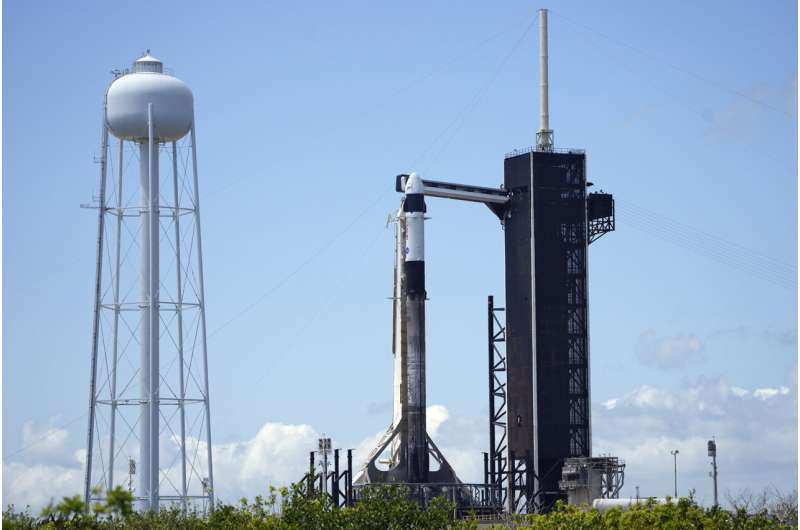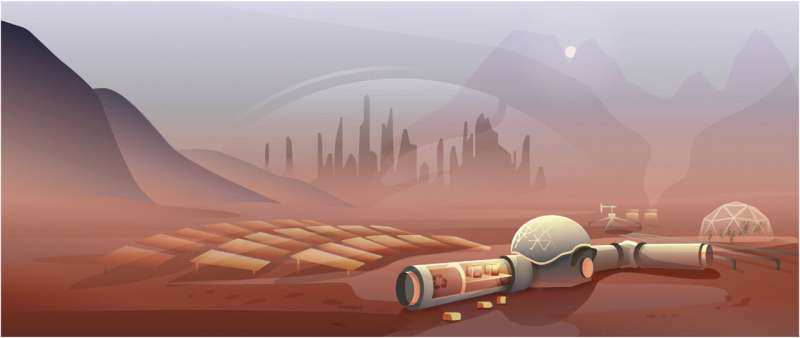
Copernical Team
SpaceX launches 4 astronauts for NASA after private flight

SpaceX launched four astronauts to the International Space Station for NASA on Wednesday, less than two days after completing a flight chartered by millionaires.
It's the first NASA crew comprised equally of men and women, including the first Black woman making a long-term spaceflight, Jessica Watkins.
"This is one of the most diversified, I think, crews that we've had in a really, really long time," NASA's space operations mission chief Kathy Lueders said on the eve of launch.
Liftoff of Crew-4 to the International Space Station
 Video:
00:03:55
Video:
00:03:55
The Falcon 9 rocket and Crew Dragon capsule carrying ESA astronaut Samantha Cristoforetti and NASA astronauts Kjell Lindgren, Robert “Bob” Hines and Jessica Watkins to the International Space Station lifts off from Launchpad 39A.
Collectively known as Crew-4, the four astronauts were launched at 08:52 BST/09:52 CEST Wednesday 27 April from NASA’s Kennedy Space Center in Florida USA. Transit to the Station is expected to take under 24 hours.
Samantha is the third ESA astronaut to travel to the orbital outpost in a Crew Dragon. During the journey she and Jessica will serve as mission specialists. Kjell is Crew-4
Watch live: Crew-4 docking to the International Space Station

Follow the live coverage as the SpaceX Crew Dragon docks on the International Space Station, marking the beginning of ESA astronaut Samantha Cristoforetti’s Minerva mission.
Scientists model landscape formation on Titan, revealing an Earth-like alien world
 Saturn's moon Titan looks very much like Earth from space, with rivers, lakes, and seas filled by rain tumbling through a thick atmosphere. While these landscapes may look familiar, they are composed of materials that are undoubtedly different - liquid methane streams streak Titan's icy surface and nitrogen winds build hydrocarbon sand dunes.
The presence of these materials - whose mechani
Saturn's moon Titan looks very much like Earth from space, with rivers, lakes, and seas filled by rain tumbling through a thick atmosphere. While these landscapes may look familiar, they are composed of materials that are undoubtedly different - liquid methane streams streak Titan's icy surface and nitrogen winds build hydrocarbon sand dunes.
The presence of these materials - whose mechani Xi Focus: Invigorating China's space exploration dream
 On April 24, 1970, a young man in a village in Northwest China's Shaanxi province was thrilled to get the news that China sent its first satellite Dongfanghong 1 into space.
That young man, Xi Jinping, later became Chinese President.
Still having his eyes on stars today, Xi, also general secretary of the Communist Party of China (CPC) Central Committee and chairman of the Central Mil
On April 24, 1970, a young man in a village in Northwest China's Shaanxi province was thrilled to get the news that China sent its first satellite Dongfanghong 1 into space.
That young man, Xi Jinping, later became Chinese President.
Still having his eyes on stars today, Xi, also general secretary of the Communist Party of China (CPC) Central Committee and chairman of the Central Mil SpaceX launches its latest crew to ISS for NASA
 Days after a SpaceX Dragon capsule crewed by wealthy adventurers splashed down off Florida's coast, another launched Wednesday, this time for a NASA mission to the International Space Station.
The Crew-4 mission blasted off from the Kennedy Space Center at 3:52 am (0752 GMT), carrying Americans Kjell Lindgren, Bob Hines and Jessica Watkins, as well as Italian Samantha Cristoforetti of the Eu
Days after a SpaceX Dragon capsule crewed by wealthy adventurers splashed down off Florida's coast, another launched Wednesday, this time for a NASA mission to the International Space Station.
The Crew-4 mission blasted off from the Kennedy Space Center at 3:52 am (0752 GMT), carrying Americans Kjell Lindgren, Bob Hines and Jessica Watkins, as well as Italian Samantha Cristoforetti of the Eu Solar beats nuclear at many potential settlement sites on Mars

The high efficiency, light weight and flexibility of the latest solar cell technology means photovoltaics could provide all the power needed for an extended mission to Mars, or even a permanent settlement there, according to a new analysis by scientists at the University of California, Berkeley.
Most scientists and engineers who've thought about the logistics of living on the surface of the Red Planet have assumed that nuclear power is the best alternative, in large part because of its reliability and 24/7 operation. In the past decade, miniaturized Kilopower nuclear fission reactors have advanced to the point where NASA considers them to be a safe, efficient and plentiful source of energy and key to future robotic and human exploration.
UAE vows 'responsible' artificial intelligence rollout
 The world's first minister for artificial intelligence says the United Arab Emirates isn't only looking for economic benefits as it seeks to become a leading nation in the sector.
The UAE's minister of state for AI, Omar bin Sultan al-Olama, said "quality of life" considerations were key, and also stressed the importance of a "responsible" rollout - with impacts potentially reverberating fo
The world's first minister for artificial intelligence says the United Arab Emirates isn't only looking for economic benefits as it seeks to become a leading nation in the sector.
The UAE's minister of state for AI, Omar bin Sultan al-Olama, said "quality of life" considerations were key, and also stressed the importance of a "responsible" rollout - with impacts potentially reverberating fo NASA selects investigation teams to join Geospace Dynamics Mission
 NASA has selected three investigation teams to join the agency's Geospace Dynamics Constellation (GDC) mission science team in studying Earth's upper atmosphere, as well as five additional investigations that will be under consideration for inclusion in the mission.
GDC is a coordinated group of satellites that will provide the first direct global measurements of the dynamic and complex re
NASA has selected three investigation teams to join the agency's Geospace Dynamics Constellation (GDC) mission science team in studying Earth's upper atmosphere, as well as five additional investigations that will be under consideration for inclusion in the mission.
GDC is a coordinated group of satellites that will provide the first direct global measurements of the dynamic and complex re NASA Chief slams China's refusal to cooperate with US
 China continues to display a lack of transparency and willingness to cooperate with the United States and other countries in space, NASA Administrator Bill Nelson said on Tuesday.
"We want cooperation that has not been forthcoming from the Chinese government (but) it takes two to tango," Nelson told a press conference at the Kennedy Space Center in Florida. "We simply haven't had any trans
China continues to display a lack of transparency and willingness to cooperate with the United States and other countries in space, NASA Administrator Bill Nelson said on Tuesday.
"We want cooperation that has not been forthcoming from the Chinese government (but) it takes two to tango," Nelson told a press conference at the Kennedy Space Center in Florida. "We simply haven't had any trans 